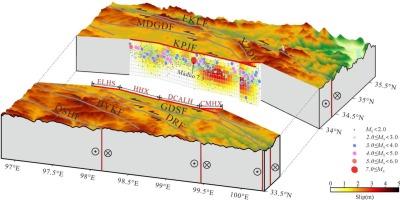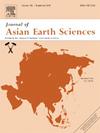Revisiting the seismic hazard of surrounding faults following the 2021 Maduo (China) MW 7.3 earthquake based on the updated co-seismic slip model
IF 2.4
3区 地球科学
Q2 GEOSCIENCES, MULTIDISCIPLINARY
引用次数: 0
Abstract
The 2021 MW7.3 Maduo (Qinghai, China) earthquake occurred on the Kunlun Pass–Jiangcuo fault within the Bayan Har block. Due to limited observational data, discrepancies exist among published co-seismic slip models, which directly impact the seismic hazard analysis for surrounding faults. In this study, we jointly inverted the co-seismic slip model of the Maduo earthquake using co-seismic observations from campaign GNSS stations, regional continuous GNSS stations, and InSAR data. Our results reveal that the geometry of the rupture fault exhibits significant variation along its strike and comprises five distinct fault segments. The earthquake exhibits a peak slip of 4.0 m, with a seismic moment of 1.69 × 1020 N m, corresponding to an MW7.42. Constrained by this co-seismic slip model, we further investigated the co- and post-seismic Coulomb stress change of surrounding faults, employing a three–dimensional viscoelastic finite element model of the eastern Bayan Har block. Our findings indicate that the Maduo earthquake induced significant stress loading (>1.0 × 104 Pa) on the Maqin–Maqu and Tuosuo Lake segments of the Eastern Kunlun fault, the southeastern segment of the Xizangdagou fault, etc. These findings, integrated with the elapsed time of historic earthquakes on both the Maqin–Maqu and Tuosuo Lake segments, which have approached or exceeded their recurrence intervals, underscore the need for increased attention to these fault segments.

基于更新的同震滑动模型重新审视2021年中国玛多mw7.3地震周边断层的地震危险性
2021年中国青海玛多MW7.3级地震发生在巴彦哈尔地块内的昆仑关-江措断裂带上。由于观测资料有限,已发表的同震滑动模型之间存在差异,直接影响了对周围断层的地震危险性分析。本研究利用运动GNSS站、区域连续GNSS站和InSAR数据的同震观测资料,联合反演了麻多地震的同震滑动模型。结果表明,断裂断层的几何形状沿其走向呈现明显的变化,由五个不同的断层段组成。地震峰滑4.0 m,地震矩1.69 × 1020 N m,对应MW7.42。在此同震滑动模型约束下,采用巴彦喀尔东部块体三维粘弹性有限元模型,进一步研究了周边断层的同震及震后库仑应力变化。研究结果表明,玛多地震在东昆仑断裂带玛琴-玛曲段、陀所湖段、西藏大沟断裂带东南段等处诱发了显著的应力加载(1.0 × 104 Pa)。这些发现,结合玛琴-玛曲段和陀所湖段历史地震的时间,表明有必要增加对这些断层段的关注,这些断层段已经接近或超过了它们的复发间隔。
本文章由计算机程序翻译,如有差异,请以英文原文为准。
求助全文
约1分钟内获得全文
求助全文
来源期刊

Journal of Asian Earth Sciences
地学-地球科学综合
CiteScore
5.90
自引率
10.00%
发文量
324
审稿时长
71 days
期刊介绍:
Journal of Asian Earth Sciences has an open access mirror journal Journal of Asian Earth Sciences: X, sharing the same aims and scope, editorial team, submission system and rigorous peer review.
The Journal of Asian Earth Sciences is an international interdisciplinary journal devoted to all aspects of research related to the solid Earth Sciences of Asia. The Journal publishes high quality, peer-reviewed scientific papers on the regional geology, tectonics, geochemistry and geophysics of Asia. It will be devoted primarily to research papers but short communications relating to new developments of broad interest, reviews and book reviews will also be included. Papers must have international appeal and should present work of more than local significance.
The scope includes deep processes of the Asian continent and its adjacent oceans; seismology and earthquakes; orogeny, magmatism, metamorphism and volcanism; growth, deformation and destruction of the Asian crust; crust-mantle interaction; evolution of life (early life, biostratigraphy, biogeography and mass-extinction); fluids, fluxes and reservoirs of mineral and energy resources; surface processes (weathering, erosion, transport and deposition of sediments) and resulting geomorphology; and the response of the Earth to global climate change as viewed within the Asian continent and surrounding oceans.
 求助内容:
求助内容: 应助结果提醒方式:
应助结果提醒方式:


